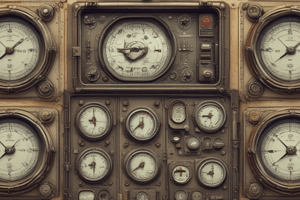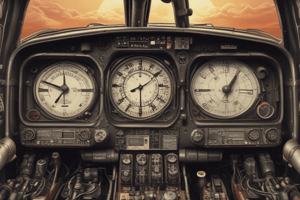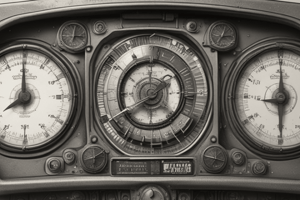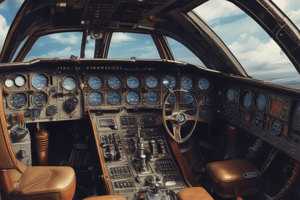Podcast
Questions and Answers
What is the primary purpose of inspecting the opening of the pitot tube during pre-flight checks?
What is the primary purpose of inspecting the opening of the pitot tube during pre-flight checks?
- To ensure the tube is securely attached to the aircraft
- To verify the last calibration date of the instrument
- To compare the reading with a known field elevation
- To check for any visible blockages that may affect airflow (correct)
What is the recommended method for checking the airflow in a pitot tube?
What is the recommended method for checking the airflow in a pitot tube?
- Using a calibrated test equipment to simulate different altitudes
- Gently blowing into the pitot tube or using a designated device (correct)
- Reviewing the aircraft's maintenance records
- Comparing the reading with a known field elevation
What is the purpose of reviewing the aircraft's maintenance records during instrument calibration verification?
What is the purpose of reviewing the aircraft's maintenance records during instrument calibration verification?
- To verify the last calibration date of the instrument (correct)
- To simulate different altitudes and airspeeds
- To determine the required range of operational pressures
- To compare the reading with a known field elevation
What is the primary purpose of a static system test during instrument calibration verification?
What is the primary purpose of a static system test during instrument calibration verification?
What is the recommended method for ensuring accurate instrument calibration?
What is the recommended method for ensuring accurate instrument calibration?
What is the consequence of deviations from expected values in instrument calibration?
What is the consequence of deviations from expected values in instrument calibration?
What is the purpose of calibrating instruments in aircraft?
What is the purpose of calibrating instruments in aircraft?
What is the recommended frequency for verifying instrument calibration?
What is the recommended frequency for verifying instrument calibration?
What is the primary purpose of airflow checks during pre-flight inspections?
What is the primary purpose of airflow checks during pre-flight inspections?
What is the benefit of implementing rigorous pre-flight checks and regular calibration verification?
What is the benefit of implementing rigorous pre-flight checks and regular calibration verification?
The calibration of instruments is a simple process that can be performed by anyone.
The calibration of instruments is a simple process that can be performed by anyone.
Airflow checks during pre-flight inspections are only necessary if a pitot tube cover was used.
Airflow checks during pre-flight inspections are only necessary if a pitot tube cover was used.
A static system test is not necessary if the aircraft's maintenance records indicate that the instruments were calibrated recently.
A static system test is not necessary if the aircraft's maintenance records indicate that the instruments were calibrated recently.
Certified maintenance personnel are not required to perform instrument calibration verification.
Certified maintenance personnel are not required to perform instrument calibration verification.
Instruments only need to be calibrated during pre-flight checks.
Instruments only need to be calibrated during pre-flight checks.
Pilots can determine the accuracy of their instruments by comparing them to other aircraft.
Pilots can determine the accuracy of their instruments by comparing them to other aircraft.
The use of a pitot tube cover is not necessary during parking or storage.
The use of a pitot tube cover is not necessary during parking or storage.
Instrument calibration verification is only necessary for altimeters.
Instrument calibration verification is only necessary for altimeters.
The pilot is responsible for performing instrument calibration verification.
The pilot is responsible for performing instrument calibration verification.
Instrument calibration verification is a one-time process.
Instrument calibration verification is a one-time process.
What potential hazard can occur if a pitot tube cover is not removed during pre-flight checks?
What potential hazard can occur if a pitot tube cover is not removed during pre-flight checks?
What is the primary reason for verifying instrument calibration against known values during pre-flight checks?
What is the primary reason for verifying instrument calibration against known values during pre-flight checks?
What is the purpose of using a calibrated external pressure source during a static system test?
What is the purpose of using a calibrated external pressure source during a static system test?
What is the consequence of not performing regular calibration verification on aircraft instruments?
What is the consequence of not performing regular calibration verification on aircraft instruments?
What is the purpose of reviewing maintenance records during instrument calibration verification?
What is the purpose of reviewing maintenance records during instrument calibration verification?
What is the role of certified maintenance personnel in instrument calibration verification?
What is the role of certified maintenance personnel in instrument calibration verification?
What is the primary benefit of implementing rigorous pre-flight checks and regular calibration verification?
What is the primary benefit of implementing rigorous pre-flight checks and regular calibration verification?
What is the purpose of comparing altimeter readings with known field elevations during pre-flight checks?
What is the purpose of comparing altimeter readings with known field elevations during pre-flight checks?
What is the primary purpose of airflow checks during pre-flight inspections?
What is the primary purpose of airflow checks during pre-flight inspections?
What is the consequence of not removing blockages or restrictions from the pitot tube during pre-flight checks?
What is the consequence of not removing blockages or restrictions from the pitot tube during pre-flight checks?
Flashcards are hidden until you start studying
Study Notes
Pre-Flight Checks: Pitot-Static System
- The pitot-static system provides critical data for airspeed indicator, altimeter, and vertical speed indicator, which are essential for safe flight experience.
- A malfunction in the pitot-static system can lead to safety hazards, making thorough inspection crucial.
Pre-Flight Inspection Procedures
- Inspect the pitot tube for blockages, ice, or debris, and remove any covers.
- Ensure static ports are unobstructed by visually inspecting and gently passing a hand over them.
- Inspect the condition and security of system hoses and connections, ensuring they are intact and tight.
- Observe the instruments for signs of pitot-static system failure, such as zero readings on airspeed indicators or anomalous readings on altimeters and vertical speed indicators.
Instrument Safety Checks
- Airspeed indicator: check for stable needle at zero.
- Altimeter: set to current airport pressure setting, indicating field elevation accurately.
- Vertical speed indicator: check for neutral or zero reading during static inspection.
Detecting Pitot Tube Blockages
- Pitot tube blockages can occur due to insects, dirt, ice, or small debris, which can lead to incorrect airspeed readings or instrument failure.
- Visual inspection: inspect the pitot tube for any obstructions or blockages.
- Manual blockage test: gently run a finger along the inside of the pitot tube to feel for any anomalies or debris.
- Test equipment: anemometer testers can be used to apply pressure and suction to the pitot tube and static system to ensure they are clear and functional.
Clearing Blockages and Verification
- Clear any detected blockages using specialized tools or equipment, often handled by maintenance personnel.
- Verify the pitot tube is clear pre-flight through a final visual check.
- Include this pre-flight verification as a routine habit to ensure accurate airspeed data.
Instrument Calibration and Verification
- Calibration of instruments is a technical process that requires specialized equipment and techniques.
- Verification process:
- Reference to maintenance records: verify the last calibration date.
- Comparison with known values: compare readings with known field elevation or performance charts.
- Static system test: perform a static system test using a calibrated external pressure source.
- Professional calibration: test instruments by certified maintenance personnel using calibrated test equipment.
Pre-Flight Checks for Pitot-Static System
- The pitot-static system provides critical data for airspeed, altitude, and vertical speed indicators in every phase of flight.
- Malfunctions in the system can lead to incorrect readings, posing a safety hazard.
Importance of Pre-Flight Inspection
- Pre-flight inspection is crucial to ensure flight readiness and prevent in-flight instrument errors.
- The pitot tube is prone to blockages due to its exterior position, and visual inspection is essential to detect any debris or ice.
Steps for Pre-Flight Inspection
- Visual Inspection: Check pitot tube and static ports for blockages, damage, or tampering.
- Physical Examination: Gently tap and wiggle the pitot tube to verify security and check for debris.
- Instrument Check: Check airspeed indicator, altimeter, and vertical speed indicator for anomalies or irregularities in readings.
- Leak Check: Perform leak check on the pitot-static system if equipped with the means to do so.
Technique for Checking Pitot Tube for Blockages
- Visual Confirmation: Inspect the opening of the pitot tube for visible blockages.
- Airflow Check: Gently blow into the pitot tube or use a designated device to create airflow and listen for air escape.
Importance of Instrument Calibration
- Instrument calibration is crucial to ensure accurate readings and prevent in-flight instrument errors.
- Calibration of instruments is a technical process that requires specialized equipment and techniques.
Process for Verifying Instrument Calibration
- Reference to Maintenance Records: Verify last calibration date by reviewing aircraft maintenance records.
- Comparison with Known Values: Compare readings with known field elevation or performance charts during specific flight conditions.
- Static System Test: Perform static system test using a calibrated external pressure source.
- Professional Calibration: Test instruments by certified maintenance personnel using calibrated test equipment.
Fundamentals of Flight Instruments: Pre-Flight Checks
- The pitot-static system provides critical data for every phase of flight, and a malfunction can lead to safety hazards.
- The system directly impacts the airspeed indicator, altimeter, and vertical speed indicator.
Pre-Flight Inspection Procedures
- Visually inspect the pitot tube for debris or ice that could clog the opening.
- Ensure the pitot tube cover is removed before flight.
- Inspect static ports for obstructions and ensure they are clean.
- Check the condition and security of system hoses and connections.
- Observe the instruments themselves for signs of pitot-static system failure.
Pitot Tube Inspection
- The pitot tube plays a crucial role in measuring airspeed, which is essential for maintaining proper flight performance.
- Common culprits behind pitot tube blockages include insects, dirt, ice, and small debris.
- A meticulous pre-flight inspection to detect any blockages is necessary.
Pre-Flight Procedures for Detecting Pitot Tube Blockages
- Visual inspection: Approach the pitot tube and inspect for any obstructions.
- Hands-on check: Conduct a cover removal confirmation.
- Manual blockage test: Ensuring the pitot tube's opening is clear.
Pre-Flight Inspection of the Pitot-Static System Components
- Visual inspection: Check the pitot tube and static ports for blockages or damage.
- Physical examination: Gently tap and wiggle the pitot tube to verify it is secure and clear.
- Instrument check: Check the airspeed indicator, altimeter, and vertical speed indicator for any anomalies or irregularities.
- Leak check: Perform a leak check on the pitot-static system if the aircraft is equipped.
Technique for Checking the Pitot Tube for Blockages
- Visual confirmation: Inspect the pitot tube opening for any visible blockages.
- Airflow check: Gently blow into the pitot tube or use a designated device to create airflow and listen for the escape of air from the system.
Process for Verifying Instrument Calibration
- Reference to maintenance records: Verify the last calibration date by reviewing the aircraft's maintenance records.
- Comparison with known values: Compare the reading with a known field elevation for altimeters and with performance charts during specific flight conditions for airspeed indicators.
- Static system test: Perform a static system test using a calibrated external pressure source to simulate different altitudes and airspeeds.
- Professional calibration: Have the instruments tested by certified maintenance personnel using calibrated test equipment.
Studying That Suits You
Use AI to generate personalized quizzes and flashcards to suit your learning preferences.




